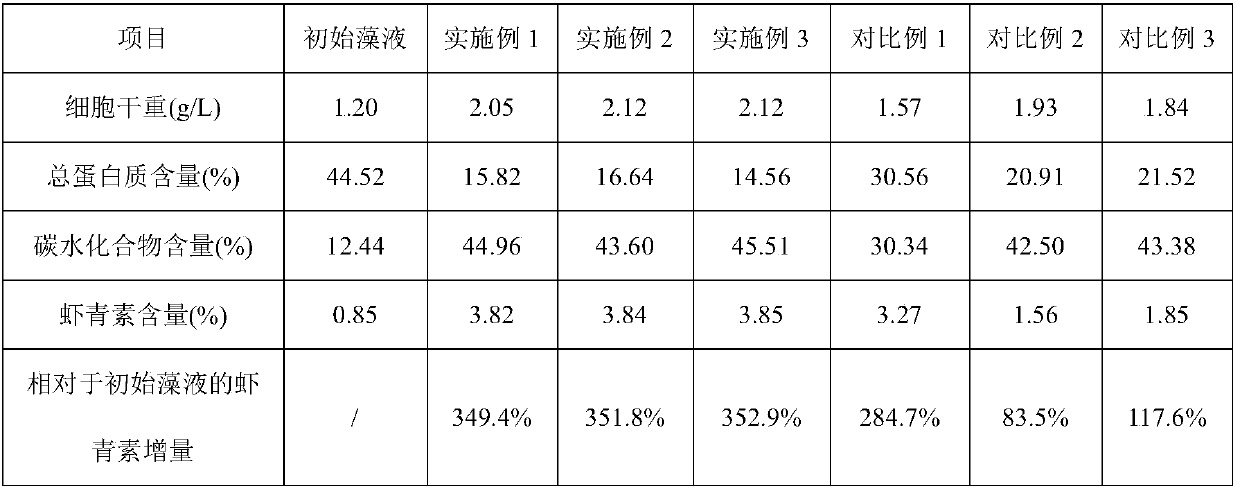Method for inducing algal cells to synthesize astaxanthin efficiently
A technology of algal cells and astaxanthin is applied in the field of inducing algal cells to efficiently synthesize astaxanthin, which can solve the problems of low astaxanthin content, high extraction cost, unsuitable for large-scale production, etc. Effects of the PP pathway and the TCA cycle
- Summary
- Abstract
- Description
- Claims
- Application Information
AI Technical Summary
Problems solved by technology
Method used
Image
Examples
Embodiment 1
[0036] The method for inducing algae cells to efficiently synthesize astaxanthin specifically comprises the following steps:
[0037] Concentrated algae liquid: Collect the high-yield astaxanthin algae liquid of Haematococcus pluvialis in the logarithmic growth phase and conduct static sedimentation, remove the supernatant culture liquid, settle and remove impurities until the concentrated algae liquid with a cell density of 25g / L is obtained ; Selecting high-yield astaxanthin Haematococcus pluvialis in the logarithmic growth phase for screening and concentration is conducive to obtaining high-quality and efficient algae liquid, and achieving the most efficient induction of astaxanthin synthesis;
[0038] Cryopreservation: Equipped with cryopreservation solution: containing 0.1wt% 1-butanol and 0.05wt‰ L-arabitol, and the rest is distilled water; at 1°C, add the cryopreservation solution to the Concentrate the algae liquid, stir and centrifuge to remove the supernatant to obta...
Embodiment 2
[0045] A method for inducing algae cells to efficiently synthesize astaxanthin, comprising:
[0046] a) Settling and concentrating the high-yield astaxanthin Haematococcus pluvialis liquid in the logarithmic growth phase;
[0047] b) After adding the freezing liquid to the concentrated algae liquid, remove the supernatant, pre-freeze and then freeze for preservation;
[0048] c) Under the blue light irradiation of 440nm, induce and cultivate the algae liquid;
[0049] d) Adding fermentation aids to the carbon-free combined medium containing glucose to carry out shaking fermentation culture.
[0050] The method of the present invention freezes and preserves the high-yield astaxanthin-producing Haematococcus pluvialis algae liquid with the cryopreservation solution, which can reduce the growth rate of ice crystals and weaken the damage to algal cells caused by the extension of ice crystals in freezing overshoot, thereby maintaining the activity of algal cells , blue light irra...
Embodiment 3
[0064] A method for inducing algae cells to efficiently synthesize astaxanthin, comprising:
[0065] a) Settling and concentrating the high-yield astaxanthin Haematococcus pluvialis liquid in the logarithmic growth phase;
[0066] b) After adding the freezing liquid to the concentrated algae liquid, remove the supernatant, pre-freeze and then freeze for preservation;
[0067] c) Under the irradiation of blue light of 420-440nm, the algae liquid is induced to be cultured;
[0068] d) Adding fermentation aids to the carbon-free combined medium containing glucose to carry out shaking fermentation culture.
[0069] The method for inducing algae cells to efficiently synthesize astaxanthin specifically includes the following steps:
[0070] Concentrated algae liquid: Collect the high-yielding astaxanthin Haematococcus pluvialis liquid in the logarithmic growth phase and conduct static sedimentation, remove the supernatant culture liquid, settle and remove impurities until the conc...
PUM
| Property | Measurement | Unit |
|---|---|---|
| melting point | aaaaa | aaaaa |
| boiling point | aaaaa | aaaaa |
| density | aaaaa | aaaaa |
Abstract
Description
Claims
Application Information
 Login to View More
Login to View More - R&D
- Intellectual Property
- Life Sciences
- Materials
- Tech Scout
- Unparalleled Data Quality
- Higher Quality Content
- 60% Fewer Hallucinations
Browse by: Latest US Patents, China's latest patents, Technical Efficacy Thesaurus, Application Domain, Technology Topic, Popular Technical Reports.
© 2025 PatSnap. All rights reserved.Legal|Privacy policy|Modern Slavery Act Transparency Statement|Sitemap|About US| Contact US: help@patsnap.com

